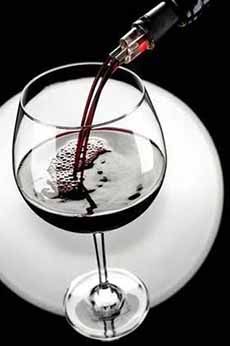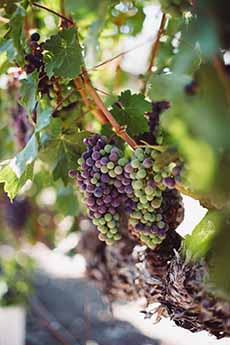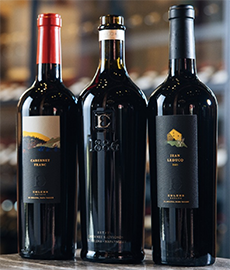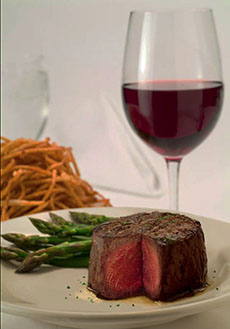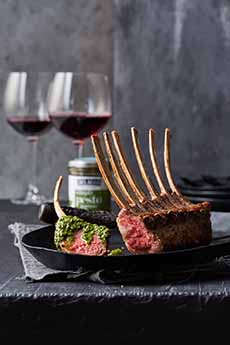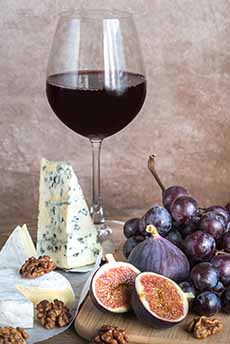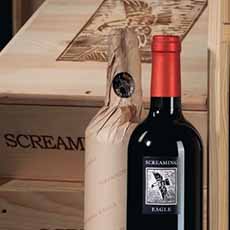All About Cabernet Sauvignon On National Cabernet Sauvignon Day
|
International Cabernet Sauvignon Day is held on August 30th, celebrating the wine made from the world’s most widely planted red wine grape varieties. It’s known by wine people as “The King Of The Reds” or simply, “King Cab.” “Cab,” for short, is grown in nearly every major wine-producing country. In fact, adaptable to various climates and soils, it can be grown on every continent except Antarctica. It’s the principal grape in most Bordeaux wines, where it is typically blended with up to five other grapes. Every year on National Cabernet Sauvignon Day, we try a new vineyard about which we’ve heard good things. This year it’s Ehlers Estate in Napa Valley. Its 100% Cabernet wines do not disappoint (photo #3). > The history of Cabernet Sauvignon is below. > So are the top food pairings with Cab. > The year’s 25 red wine holidays. Despite its prominence as the most cultivated wine grape in the world, Cabernet Sauvignon is a relatively new variety (more about in the history of the grape, below). One reason for its popularity—beyond its deliciousness—is its ease of cultivation. Cab is grown and produced along a diverse spectrum of climates from Australia and British Columbia, from Texas to Lebanon’s Beqaa Valley. The grapes have thick skins. The vines are hardy and naturally low-yielding, which means fewer grapes per cluster and more concentrated juice. And it’s able to age well due to its high tannins. The grapes bud late, which avoids remnant frost from the winter; and are resistant to viticultural hazards such as rot and insects that plague other grape varietals. Regardless of where it is grown, the wines have a consistent presentation of structure and flavors that immediately signal the typicity of Cabernet Sauvignon (i.e., you know it’s a Cab). There is one major negative: Cab’s widespread popularity and expansion across the world’s wine regions have made it a “colonizer.” It can take over wine regions at the expense of indigenous grape varieties, which are pulled up to plant Cabernet Sauvignon. Classic Cabernet Sauvignons are full-bodied wines with high tannins and good acidity, both of which contribute to the wine’s aging potential. In cooler climates, Cab tends to produce wines with blackcurrant notes that can be accompanied by notes of cedar, green bell pepper, and mint. The nuances become more pronounced as the wine ages. In moderate climates, the black currant notes are often combined with flavors of black cherry and black olive. In hot climates, the currant flavors can become over-ripe and “jammy.” In the Coonawarra wine region of South Australia, Cabernet Sauvignon, the wines tend to have characteristic eucalyptus or menthol notes. Before we focus on the history of Cabernet Sauvignon, let’s start with the other grapes from the area that made Cab famous: the Bordeaux region of southwestern France. There’s great variation in any type of wine, based on the terror in which the grapes are grown. But for Bordeaux, by law, five other grapes can be blended with Cabernet Sauvignon to create the famous “Bordeaux Blend.” What will be blended with Cabernet Sauvignon, and in what percentage, depends on the grapes in any particular year, as well as the winery’s classic style. Until very recently, the origin of Cabernet Sauvignon was not understood. The first estates known to have actively grown grapes they called Cabernet Sauvignon (and likely supplied the vines to other estates) were Château Mouton and Château d’Armailhac, both in Pauillac, a commune (municipality) in the Haut-Médoc. But it wasn’t until 1996 that the grape’s real origins were discovered via DNA typing‡. At the University of California’s U.C. Davis Department of Viticulture and Enology, testing determined that Cabernet Sauvignon was the offspring of the red Cabernet Franc and the white Sauvignon Blanc. It was most likely a chance natural crossing that occurred in the 17th century. In 2016, the scientists at U.C. Davis announced they had sequenced a draft of the whole genome of the grape. Cabernet Sauvignon was the first genome of a commercial wine-producing grape to be sequenced [source]. Back to the 18th century: From France, the grape spread across Europe and to the New World and Oceania, and today is planted in significant amounts in: However, it regained the crown in 2015: Cabernet Sauvignon had once again become the most widely planted red wine grape worldwide. The intense, bold flavors of Cabernet Sauvignon pair best with heartier and richer foods. That’s why steak and lamb are the two foods most often mentioned. But here’s a lengthier lineup. |
|
|
|
A California Cabernet Sauvignon put American wines on the world map of great wines. Wine connoisseurs had largely looked to France for their red wines. At The Judgment of Paris of 1976 in blind tasting, a Napa Cabernet Sauvignon, 1973 Stag’s Leap Wine Cellars, bested the top Bordeaux wines, proving that world-class wines could be made in California. *The world’s largest planted wine grapes, including red and white, are Cabernet Sauvignon, 840,000 acres (340,000 hectares); Merlot, 657,300 acres (266,000 hectares); Tempranillo, 570,800 acres (231,000 hectares); Airén, 538 700 acres (218 000 hectares); Chardonnay, 518,900 acres (211,000 hectares); Syrah, 470 000 acres (190,000 hectares); Grenache Noir, 402,780 acres (163,000 hectares); Sauvignon Blanc, 299 000 acres (121,000 hectares); Pinot Noir, 285,000 acres (115,000 hectares); Trebbiano Toscano / Ugni Blanc, 274,300 acres (111,000 hectares). Airén is a white grape that is very popular in Spain, often for unpretentious wines [source]. Cab is also planted in Italy, and there are nine distinct regions in China, accounting for roughly 70% of China’s wine-producing vines [source]. †The five principal red grapes of Bordeaux are Cabernet Sauvignon plus Cabernet Franc, Malbec, Merlot, and Petit Verdot; a sixth, Carmenère, is also used. Each grape has a different purpose in the blend. Cabernet Franc and Merlot are the two largest “blenders” in a Cab blend, with smaller amounts of Carmenère, Malbec, and Petit Verdot. The Bordeaux red blend is celebrated for producing majestic wines, capable of aging for 20 to 30 years. These wines tend to be full-bodied, with tart black currant and violet notes from the grape, and cedar and cigar box notes from French oak aging. They provide fine examples of how an Old World Cabernet Sauvignon should smell and taste [source]. ‡Prior to the discovery with DNA, earlier in the 20th century, this relationship had been suspected based on the similarity of the grapes’ names and the fact that Cabernet Sauvignon shares similar aromas with both grapes (the blackcurrant and pencil box aromas of Cabernet Franc and the grassiness of Sauvignon Blanc. CHECK OUT WHAT’S HAPPENING ON OUR HOME PAGE, THENIBBLE.COM.
|
||
